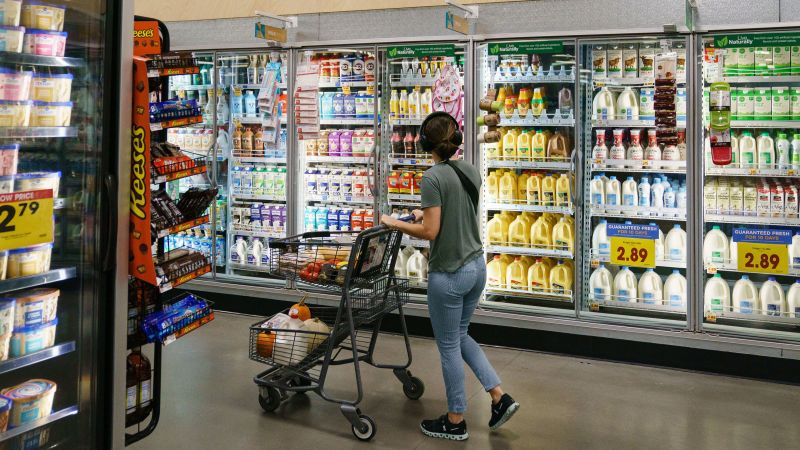New York
CNN
—
It’s been a tough year for US consumers, who battled decades-high inflation for the majority of the year and even saw gas prices hit $5 in June.
The latest inflation data, not adjusted for seasonal swings, shows price hikes have now slowed to 7.1% for the year through November, after hitting a pandemic-era peak of 9.1% in June, according to the Bureau of Labor Statistics.
From November 1 to December 24, shoppers still had to dig deep for gifts, with retail sales jumping 7.6%, unadjusted for inflation, compared to the same period last year, according to the Mastercard Spending Pulse, which tracks retail sales, excluding automotive sales. Holiday meals were also more expensive, and food prices outpaced inflation throughout the year.
But while some items saw massive double-digit increases in 2022, others were a deal. Here’s how prices changed this year.
Consumer demand for big-ticket electronics has fallen recently, leading stores to discount.
In the year through November, several major electronics got cheaper: Smartphone prices plunged 23.4%, TV prices dropped 17% and computers got 4.4% less expensive.
The price of major appliances fell 1%.
Earlier in the year, chains like Best Buy and Walmart stocked up on merchandise, preparing for supply chain shortages and what they projected to be robust consumer demand. But their plans were derailed by inflation and slumping consumer confidence.
Plus, many consumers had already made large purchases or upgrades while stuck at home early in the pandemic.
Apparel prices rose, but slowly. Clothing increased 3.6%, while footwear rose 2.3%. Sporting goods increased 2.7% and toys 0.6%.
The increases made these items a relative bargain, as they were all outpaced by overall inflation.
“In toys, sporting goods, apparel, categories like that, prices have come down more aggressively,” Walmart CEO Doug McMillon said in an interview on CNBC in December. “We’re still inflated but we’re not inflated nearly as much as we are in the other categories.”
Here, again, many retailers misjudged consumer demand and so had excess inventory pile up. To clear out merchandise and entice shoppers to buy, stores ramped up promotions. This kept prices in check.
This year, demand for air travel roared back after falling to an all-time low in 2020. Plane ticket prices jumped 36% annually in the year through November.
In March, Delta president Glen Hauenstein called the spike in demand “unprecedented,” adding “I have never seen … demand turn on so quickly as it has after Omicron,” the Covid-19 variant that caused cases to spike last winter.
Many airlines reported record revenue in April, May and June thanks to high airfares and full planes as travelers returned in full force two years into the pandemic.
On the ground, travel got more expensive, as well. Gasoline prices were up 10.1% for the year, but are now off their record highs. Volatility in gas prices was largely due to Russia’s invasion of Ukraine and geopolitical maneuvers that used oil supply as a tool.
Still, the national average could still climb back above the $4-a-gallon threshold as soon as May, according to GasBuddy projections shared with CNN.
GasBuddy, an app that tracks fuel prices, doesn’t anticipate another year of extreme volatility, however.
In the year through November, food got 10.6% more expensive, outpacing overall inflation.
In that period, several individual grocery items got even pricier for a variety of reasons.
Egg prices shot up a massive 49.1%, due to a supply shortage caused by a deadly avian flu, coupled with high demand.
Margarine got 47.4% pricier because of price swings in the vegetable oil market caused largely by the war in Ukraine, while butter got 27% more expensive after a contraction in the global milk supply.
Another staple, flour, got 24.9% more expensive due to the war in Ukraine’s impact on the global grain market and high transportation costs in the United States. Even lettuce saw a 19.8% increase, due to crop disease in California.
Overall, grocery prices jumped 12% in the period, with many consumers accepting the higher prices as thriftier alternatives to restaurant meals, which also grew more expensive, though at a slower clip. Food away from home became 8.5% more expensive in 2022, with many restaurants hiking up menu prices in order to mitigate their own higher input costs.
— CNN’s Matt Egan and Chris Isidore contributed to this report.
Note:- (Not all news on the site expresses the point of view of the site, but we transmit this news automatically and translate it through programmatic technology on the site and not from a human editor. The content is auto-generated from a syndicated feed.))




Can you be more specific about the content of your article? After reading it, I still have some doubts. Hope you can help me.
Thanks for sharing. I read many of your blog posts, cool, your blog is very good.